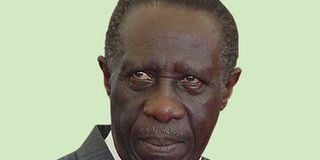Prime
Bane of artistes: Princes in life, paupers at death

Kakoma was honoured for his work with the National Anthem.
What you need to know:
Vicious circle. Many artistes are at the mercy of managers, for many of whom honesty is scarce.
Comedian Jimmy Kiyingi alias Kadoma died on February 9, and Eagles Production’s Fred Maiso on February 13. Only Maiso’s vigil was held at the Uganda National Cultural Centre. To the casual analyst it looked like Maiso deserved the exception on the basis of his being the more and longer established of the two.
Or perhaps due to the furore surrounding the circumstances of his death; Bobi Wine on one hand drumming up financial support to meet Maiso’s hospital bills, Eagle’s frontman Mesach Semakula maintaining on the other that he had not even spent half of what was allocated to his welfare.
Skeptics maintained he was brought to the theatre for the same reason Edel Akongu Ekodelele was in December 2002, and the Ebonies’ Cissy Muwanga on August 16, 2011; that at the time of death, they either had homes not befitting artistes of their status, or had no place to call home.
And then, there are those with homes (personally owned or rented) good enough to hold their vigils without need of public relations considerations.
But as the case of Prince Job Paul Kafeero shows, leaving behind no legacy to take care of the family makes an anti-climax to the fame and fortune that once defined an artiste’s career.
Had such fame translated into financial security, perhaps the composer of our national anthem would not have had such a fractured relationship with all the governments which played ping-pong with his royalties.
Yet performing art is literally big business, especially when artistes get recognition due to their work. From the outside looking in, no artiste with any measure of success should die a pauper. Product endorsements with ten-figure earnings, heavily-sponsored concert launches, extravagant designer collections, swanky studios and cars, swankier mansions, private beaches, showy spending sprees, weddings fit for kings, all seem to be theirs for the taking.
So how and why, amidst all the glamour, are some artistes like the saucepan which cooks but never eats?
According to Frank Katoora, Artistic Director of the Creative Connections Programme at Tender Talents Magnet School, lack of professionalism is the heart of the matter.
No seriousness
“All these artistes should have had personal advisers to help brand and market their artistic ability and also secure their financial futures. But here artistes still refuse to take their craft seriously enough to invest in planning for how they will reap long-term benefits from it,” he says.
The advisers are sometimes the very ones responsible for exploiting the naivete of most artistes. Those in the upcoming-artiste category are the most susceptible, falling prey to handlers who rarely deliver on the usually verbal promises they make.
“Some are blinded by optimism and don’t read the contracts through. They later are held hostage under the terms and conditions they should have had a lawyer advise them about,” says Herman Bagonza, Artistic Director of Rhythm Africa cultural troupe.
At other times though, artistes choreograph their own falling from grace or failing to achieve it. For years they subsist in carpe diem mode, nonchalantly whittling away their earnings on the fast life that supposedly marks their having finally ‘made it’. Some remain just as extravagant even when their careers are still in formative stage.
George Kitaka, Director of the Vox Ange Choir, calls it the ‘most popular method of self-destruction.’ “When a formerly starving artiste tastes money and fame, their thirst for the good life sucks away what little sense they had starting out. They cheapen their art and themselves by not having a defined performing fee or pedigree of audience. Anything goes as long as it solves their next short-term problem, be it food or rent,” he says.
In time, this translates into living beyond one’s means, which becomes a tradition especially for artistes desperate to maintain their image and reputation in the eyes of a critical media and impressionable public. In practice, there is no better explanation for the popular portrait of the artist as “someone with a high likelihood of dying broke and disillusioned with the world.”
Crooked managers and artistes without enough street smarts meet headlong at branding campaigns. Conniving agents use them to bog down artistes who agree to them, more unwittingly than not. Dido’s “Nothing I have/ is truly mine” line from the song Life For Rent comes to mind.
Andrew Lwanga Ssebagala, CEO of House of Talent, says: “A business-savvy manager convinces the artiste of the need to accumulate status symbols. Usually it is the terms of how much of the collaboration’s money goes to achieving and maintaining this impression to fellow artistes and the public that creates the problem”.
Might we need to go the way of Senegal, which amended its constitution on March 12, to provide health, housing and pension schemes to leading artistes who are approaching the sunset of their creative careers?




